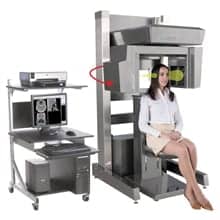CHICAGO, Dec. 2, 2009 – When a patient comes to a hospital’s emergency department (ED) exhibiting stroke symptoms, it can take hours to diagnose and treat the patient when time is of the essence. Toshiba’s Aquilion® ONE dynamic volume CT system has the ability to improve the quality of life for patients with neurological symptoms, especially related to stroke, by reducing diagnosis time to minutes. Highlighting these capabilities, Toshiba America Medical Systems, Inc. will feature the Aquilion ONE at this year’s Radiological Society of North America (RSNA) annual meeting, held in Chicago, Nov. 29 – Dec. 4 (Booth #5629, South Hall).
The Aquilion ONE allows physicians to reduce diagnosis time for life-threatening conditions such as a stroke from hours or days to minutes. Unlike any other CT system available, the Aquilion ONE covers up to 16 cm of anatomy using 320 ultra-high resolution 0.5 mm detector elements to image an entire organ, including the brain, in a single rotation. It can show the organ’s dynamic blood flow and real-time function. The ability to see dynamic function, such as blood flowing through the brain, is critical for stroke patients in emergency settings and enables rapid and accurate diagnosis when time is critical.
This Neuro ONE acute stroke imaging protocol on Aquilion ONE combines non-contrast CT, cerebral blood flow analysis and four-dimensional digital subtraction angiography (DSA) into a single exam. By combining these exams into a single low dose protocol, full stroke workup can be performed in less than five minutes.
Beyond brain imaging, Toshiba offers a suite of automated technologies for ensuring low dose and diagnostic image quality such as SUREExposure™, QDS, SURECardio™ Prospective, Active Collimation and Variable Helical Pitch (vHP).
PinnacleHealth, based in Harrisburg, Pa., which is ranked as one of the best hospitals by U.S. News and World Report, is experiencing the capabilities of the Aquilion ONE in stroke diagnosis on a daily basis.
“Toshiba’s Aquilion ONE is helping us improve patient care in our high-volume ED by diagnosing life-threatening conditions, like stroke, quickly,” said Karen Botts, director of Imaging, PinnacleHealth. “The comprehensive data produced by the system allows us to detect if a patient is having a stroke and if so, what type and how much damage has been caused, all of which is critical to plan appropriate treatment.”
PinnacleHealth used this technology to receive a Joint Commission’s Certificate of Distinction for Primary Stroke Centers accreditation, which requires centers to diagnose stroke within 45 minutes of patient arrival. The hospital anticipates it will have nearly 90,000 annual patient visits to its ED over the next few years.
“Identifying stroke at its earliest stages is critical to develop the best treatment path and improving the life of the patient, as every minute counts in stroke diagnosis,” said Doug Ryan, senior director, CT Business Unit, Toshiba. “We designed the Aquilion ONE for low dose stroke diagnosis, and PinnacleHealth’s stroke program will utilize the capabilities of the system.”
Source: Toshiba Press Release





